A Sun Halo, also known as a 22-degree halo, is a fascinating natural phenomenon that occurs when light is refracted by ice crystals in the Earth's atmosphere. These halos appear as bright, circular rings around the sun, often with a diameter of around 22 degrees.

Sun halos are caused by the interaction of light with hexagonal ice crystals that are present in high altitude cirrus clouds. When light passes through these crystals, it is refracted, or bent, at an angle of around 22 degrees. This causes the light to scatter in a specific way, creating a circular ring around the sun.
The diameter of the halo is always around 22 degrees, regardless of the size or distance of the ice crystals. This is because the angle of refraction is always the same for all ice crystals that are oriented at the same angle to the sun.
Sun halos are most commonly seen when the sun is low in the sky, such as during sunrise or sunset. This is because the light has to travel through a greater distance of atmosphere, increasing the likelihood of it encountering ice crystals and creating a halo.
In addition to the 22-degree halo, there are several other types of halos that can occur around the sun. These include the 46-degree halo, the upper tangent arc, and the lower tangent arc. Each of these halos is caused by a different arrangement of ice crystals and can have a slightly different appearance.
Sun halos are a beautiful and awe-inspiring sight, and have been the subject of fascination and mythology for centuries. In some cultures, they are seen as a symbol of good luck or a sign of impending change. In modern times, they are also of scientific interest, as they can provide insights into the composition and behavior of the Earth's atmosphere.
Overall, sun halos are a fascinating natural phenomenon that demonstrate the incredible beauty and complexity of the world around us. Whether viewed as a scientific curiosity or a mystical omen, they continue to captivate and inspire people of all ages and backgrounds.